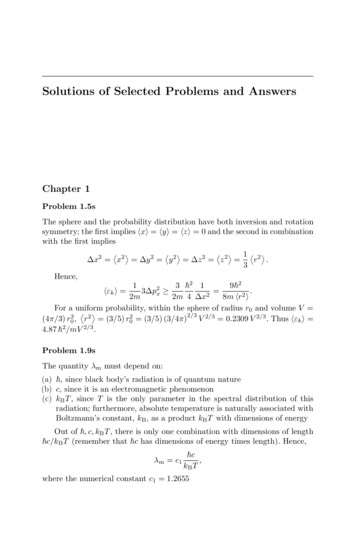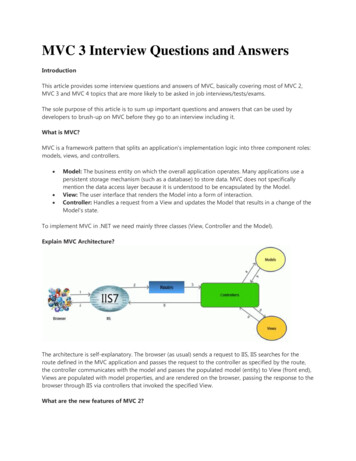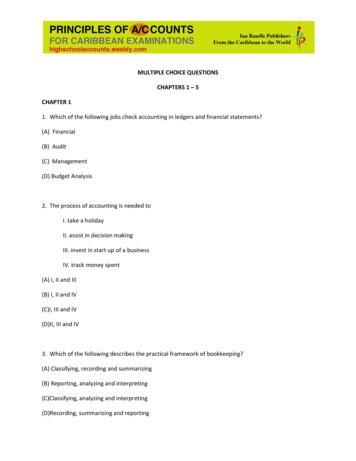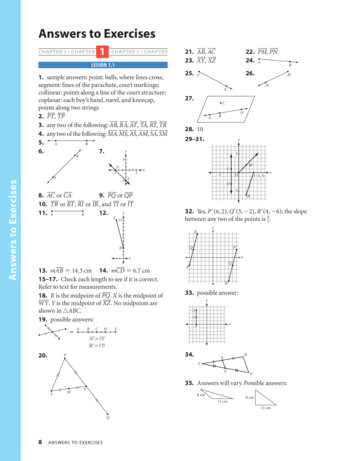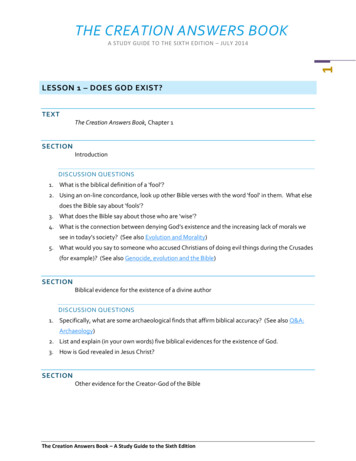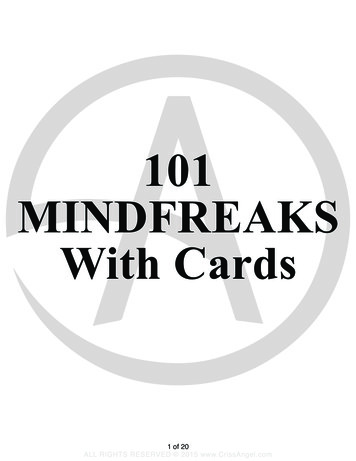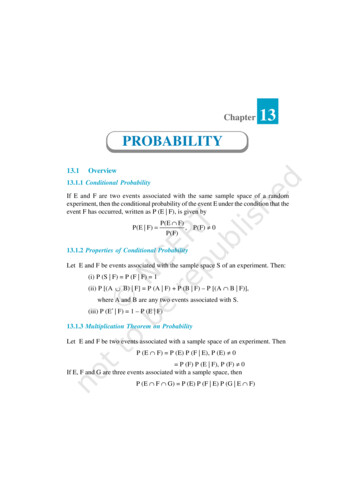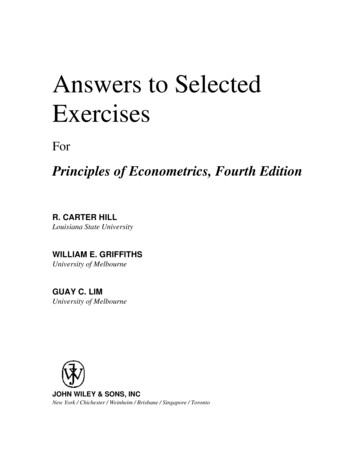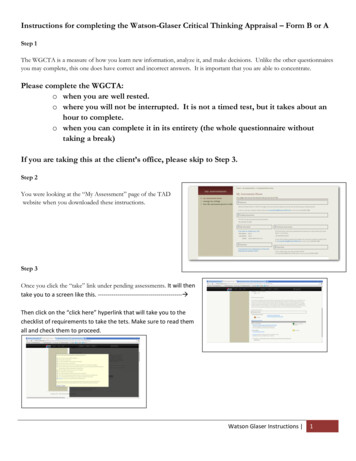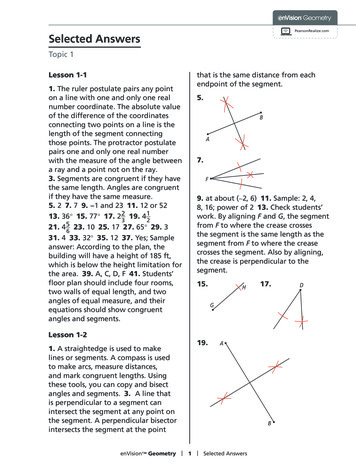
Transcription
PearsonRealize.comSelected AnswersTopic 1Lesson 1-1that is the same distance from eachendpoint of the segment.1. The ruler postulate pairs any pointon a line with one and only one realnumber coordinate. The absolute valueof the difference of the coordinatesconnecting two points on a line is thelength of the segment connectingthose points. The protractor postulatepairs one and only one real numberwith the measure of the angle betweena ray and a point not on the ray.3. Segments are congruent if they havethe same length. Angles are congruentif they have the same measure.5. 2 7. 7 9. 1 and 23 11. 12 or 522 19. 4 1 13. 36 15. 77 17. 2 325 23. 10 25. 17 27. 65 29. 321. 4 631. 4 33. 32 35. 12 37. Yes; Sampleanswer: According to the plan, thebuilding will have a height of 185 ft,which is below the height limitation forthe area. 39. A, C, D, F 41. Students’floor plan should include four rooms,two walls of equal length, and twoangles of equal measure, and theirequations should show congruentangles and segments.5.BA7.F9. at about (–2, 6) 11. Sample: 2, 4,8, 16; power of 2 13. Check students’work. By aligning F and G, the segmentfrom F to where the crease crossesthe segment is the same length as thesegment from F to where the creasecrosses the segment. Also by aligning,the crease is perpendicular to thesegment.15.GLesson 1-219.1. A straightedge is used to makelines or segments. A compass is usedto make arcs, measure distances,and mark congruent lengths. Usingthese tools, you can copy and bisectangles and segments. 3. A line thatis perpendicular to a segment canintersect the segment at any point onthe segment. A perpendicular bisectorintersects the segment at the pointenVision Geometry H 17.AB1 Selected AnswersD
PearsonRealize.comSelected AnswersTopic 121.has the length of half and a half of ahalf (so it is three quarters the lengthof the original side). Copy an adjacentangle. Then make sure the other side ofthe angle is three quarters the lengthof the original side. Repeat until allsides and angles have been copied.K23.Lesson 1-3DE1. The midpoint of a segment isdetermined by applying the Midpointformula to the coordinates of theendpoints of the segment. Thelength of a segment is determined byapplying the Distance Formula to thecoordinates of the endpoints of thesegment. 3. PM MQ; PQ 2PMGF25. 22.5 ft by 30 ft, 675 ft 2 ; x is width,1.5x is length. 5x 300, so x 60. Thedimensions of the gym are 60 ft by90 ft. The width is bisected, so onedimension of each section is 30 ft. Thelength is bisected to get 45 ft, andthen bisected again to get 22.5 ft.27. m NPM 2(m QPM) 29. Part A Sample:1 7. 15 9. a. 3, 11 5. ( 1, (2)2) 4 , b b. K( a 4 ) a c 11. a 2, Sample: Set up simultaneousequations in two variables and solve for a.2a b 1 5 3, a 3b 5 a 2.2213. (4, 22) and (11, 15); Using thePythagorean Triple 8, 15, 17, where17 is the straight line distance, 8 isthe horizontal distance, and 15 is thevertical distance, add 8 to 4 and 15 to7 to get (4, 22). Switch 8 and 15 to get(11, 15). 15. (0.8, 3.4 ) 17. ( 12 , 9) 5 21. Jamie; Arthur is1 , 3 19. (1 15 12 )Part B Check students’ work. Bisectan original side. Then copy a segmentwith the length of one half. Next, copyan adjacent angle. Then make surethe other side of the angle is half thelength of the corresponding originalside. Repeat until all sides and angleshave been copied. Part C Bisect a side.Then bisect a half. Copy a segment thatenVision Geometry b d about 45 yards away and Jamie is onlyabout 28 yards away. 23. ( 19 , 5) ;32 [(9, 3) – (1, 9)] (1, 9) (1, 9) 3192 (8, –6) ( 3 , 5) 25. Yes; the distance3is 24 2 44 2 50.1 meters. 27. D2 Selected Answers
PearsonRealize.comSelected AnswersTopic 1Lesson 1-4regions. 21. D 23. Part A Answersmay vary. Sample conjectures: If there isa vote on Proposition 3, then it is likelyto pass. If the survey is representativeof the population, then Proposition 3is likely to pass. Sample explanation: Ina survey of 300 people, half would be150. Since more than 150 people arefor Proposition 3, it is likely to pass.Part B Answers may vary. Sample:about 4,0001. Answers may vary. Sample: Byobserving cases or patterns, you canmake generalizations that could applyto all cases or can be used to predictresults. 3. conjecture 5. 2n 7. Abby’sstatement is a conjecture. She hasshown that it is true for the first 20values of n, but she has not proven itfor all values of n. 9. Answers may vary.Sample: In order to prove or disprovethis statement, I would look at everywhole number between 7,608 and7,620 and show whether it is prime orcomposite. If any of the numbers areprime, then a counterexample existsand the statement is false. If noneof the numbers are prime, then thestatement is true because there area finite number of cases and all ofthe cases would have been tested.Lesson 1-51. Answers may vary. Sample: Identifythe cause and effect. The cause is thehypothesis for a conditional statementand the effect is the conclusion.3. negation 5. Answers may vary.Sample: The inverse and contrapositiveare alike because the hypothesisand the conclusion are negated. Theinverse and contrapositive are differentbecause in the contrapositive, thehypothesis and the conclusion areswitched. 7. Hypothesis: A rectanglehas an area of 12 m 2 . Conclusion: Therectangle has sides of length 3 m and4 m. 9. Converse: If a rectangle hassides of length 3 m and 4 m, then ithas an area of 12 m 2 ; true. Inverse:If a rectangle does not have an areaof 12 m 2 , then it does not havesides of length 3 m and 4 m; true.Contrapositive: If a rectangle does nothave sides of length 3 m and 4 m, thenit does not have an area of 12 m 2 ; false.11. The hypothesis “20 is a multiple of3” is false. When a conditional has afalse hypothesis, then its truth value istrue regardless of the conclusion.32 , 64 13. Each year, about 65% , 11. 169 27 81of the senior class have their driver’slicense. 15. Answers may vary.Sample:17. a. Answers may vary. Sample: Thedata for the four groups is very close.In all four trials, between 20% and23% of subjects reported better sleep.Therefore, a reasonable conjectureis that the herb is between 20% and23% effective in improving sleep.b. Answers may vary. Sample: Between200 and 230 subjects will report bettersleep. 19. 1 2 3; 3 4 7; 7 6 13; 13 8 21; the pattern is to addsuccessive multiples of 2. A designwith 6 circles has 21 10 31 separateenVision Geometry 3 Selected Answers
PearsonRealize.comSelected AnswersTopic 113. She reversed the hypothesis andconclusion. The correct conditional is,“If water is below 0 C, then it freezes.”15. No; Sample: If the contrapositive isfalse, then the inverse is true. 17. Thehypothesis is true and the conclusionis false. 19. If I cut my hair, then it willbe shorter. 21. If it is Tuesday, thenmovie tickets are half-price. 23. False;Sample: 3 10 30 25. Negationof hypothesis: Both whole numbers areodd or both whole numbers are even;Negation of conclusion: The sum of thetwo numbers is even. 27. If an angle isnot obtuse, then it does not measure100 . This is true because only obtuseangles are larger than 90 and lessthan 180 . All other angles are equalto or smaller than 90 . 29. Answersmay vary. Sample: The converse ofthe conditional is, “If 53% of the dogsare male, then 47% of the dogs arefemale.” This is true because the dogsthat are not male are female. Sinceboth the conditional and its converseare true, the biconditional is true.31. If two angles are complementary,then their measures add up to 90 . Ifthe measures of two angles add up to90 , then they are complementary.33. Answers may vary. Sample: If I am65 inches tall in the morning, then I am64.35 inches tall in the evening.35. a. If the day is Monday, then thescience museum is closed. b. If the dayis Thursday, then the science museumis open from 10 a.m. to 8 p.m.c. Converse: If the science museum isopen from 10 a.m. to 8 p.m., then theday is Thursday. Inverse: If the day isnot Thursday, then the science museumenVision Geometryis not open from 10 a.m. to 8 p.m.Contrapositive: If the science museumis not open from 10 a.m. to 8 p.m.,then the day is not Thursday. Theconverse is false, the inverse is false,and the contrapositive is true. d. Theconditional in part (a) can be writtenas a biconditional but the conditionalin part (b) cannot. The converse of part(a) is true, but the converse of part (b)is false. The day is Monday if and only ifthe science museum is closed. 37. DLesson 1-61. Answers may vary. Sample: Inductivereasoning is based on observedpatterns. Deductive reasoning is basedon logic. 3. Answers may vary. Sample:Deductive reasoning uses facts andlogic to reach a valid conclusion whileinductive reasoning looks at patternsto reach a conjecture which may notbe proven to be valid. 5. Casey has afever; Law of Detachment. 7. If youeat too much, you want to rest.9. Samantha uses the same hypothesisfor both conditionals so she can’tcombine the two using the Law ofSyllogism. 11. Figures A, E 13. No;for any conditional, if the hypothesisis true, a true or false conclusionresults in the conditional being true.15. The Law of Detachment cannotbe used because the hypothesis of theconditional is not given to be true.17. The Law of Detachment cannotbe used because the hypothesis of theconditional is not true. 19. The Law ofSyllogism cannot be used because thehypothesis of one conditional is not theconclusion of the other. 4 Selected Answers
PearsonRealize.comSelected AnswersTopic 121. If it is Thursday, then he eats grilledchicken for dinner. Charles has baseballpractice. He eats grilled chicken fordinner. 23. p Avery draws a numbercard from 4 to 10.q He moves his game piece intohome base.r He wins the game.If r is false, then p q and q r arefalse. The contrapositives r q andq p are true; by the Law of Syllogism,the contrapositive r p is true, soby the Law of Detachment, since r isfalse, p is false. You can conclude thatAvery does not draw a number cardfrom 4 to 10. 25. No; you need toknow if someone ate fish and chips orif someone ate tacos. 27. D N are right angles. 13. Since VZXand WZY are right angles, VZW iscomplementary to WZX and XZYis complementary to WZX. By theCongruent Complementary Theorem, VZW XZY. 15. x 22; 109 ;109 17. x 25; 125 ; 125 19.StatementsReasonsLesson 1-721. Division A 97.2 , Division B 82.8 ,Division D 64.8 , Division F 46.8 . ByVertical Angles Theorem and the AngleAddition Postulate, the measure ofDivision C is 97.2 64.8 32.4 . Bythe Supplementary Angles Theoremand the Angle Addition Postulate, themeasure of Division E is 180 (32.4 64.8 46.8 ) 36.0 . Division C is9%, and Division E is 10%. To find thepercentages, multiplying the degreemeasure by 100 and divide by 360 .23. a. 1 2; Theorem 1-4b. 3 4; Vertical Angles Theorem25. A1) 1 and 2 are compl.2) m 1 m 2 90 3) m 1 23 4) 23 m 2 90 5) m 2 67 6) m 2 m 3 180 7) 67 m 3 180 8) m 3 113 1. A proof starts with a givenstatement and then includes a seriesof steps using deductive reasoning toexplain why a conjecture is true. 3. Youassume a postulate to be true withoutproof. A conjecture is a conclusionyou reach by inductive reasoning.A theorem is a conjecture that hasbeen proven. 5. m ADC m ADB m BDC 7. All right angles arecongruent. 9. Def. right angles, Subst.Prop., Def. angles 11. Because Mand N are congruent, m M m Nby the definition congruent angles.Because M and N are supplementary,m M m N 180 . Substitute m Mfor m N to get m M m M 180 ,or 2m M 180 . Use the DivisionProperty to get m M 90 . Substitutem N for m M to get m N 90 . Bythe definition of right angles, M andenVision Geometry 1)2)3)4)5)6)7)8)GivenDef. compl. sGivenSubst.Subtr. Prop.Linear Pairs Thm.Subst.Subtr. Prop.Lesson 1-81. The initial assumption must befalse. 3. The student should assume m 2 30 . 5. Given the conditional p q , the statement you assume isnot q. The statement you try to proveis not p. 7. Today is not Saturday.5 Selected Answers
PearsonRealize.comSelected AnswersTopic 19. Assume ‾PQ is not perpendicular to ‾ST .11. Assume LM 6. From thediagram, KL 6, so LM KL, andby the definition of a perpendicularbisector, ‾NJ cannot intersect ‾KM at‾its midpoint. Therefore NJ cannot bethe perpendicular bisector of ‾KM . Thiscontradicts the original statement,so the assumption must be wrong.Therefore LM 6 . 13. Contrapositive:If x y , then TUV and WXY are notcongruent. Assume x y . Given m TUV ,substitute x y to get y 2 xy x 2 x 2 2 x 2 . Given m WXY , substitute x y to get 3x(x y) 3x(x x) 6 x 2 . Since 2 x 2 6 x 2 , you can conclude that TUVand WXY are not congruent, whichproves the contrapositive. Thereforethe conditional statement is true: If TUV WXY , then x y . 15. Paige isnot in Mr. Green’s 2nd period class.17. ST TU UV 150 19. I and III21. Assume x 3y . Then x y 3y y 4y. Also, 2x y 2(3y) y 5y .Since EFG and HFJ are vertical angles, x y must equal 2x y , which implies4y must equal 5y. But 4y 5y only if y 0 , and y cannot equal 0 if x y 2x y . The assumption is thereforefalse, so x 3y . 23. a. x 2 h 2 d 2 b. Contrapositive: If d does notdecrease, then x does not decrease.Assume d does not decrease. Theneither d remains the same or dincreases. Suppose d remains thesame. Since x 2 d 2 h 2 , and since h isa constant, d 2 h 2 does not change,so x does not change. Suppose dincreases. Then since x 2 d 2 h 2 ,and since h is a constant, d 2 h 2 increases, so x increases. In either case,enVision Geometryx does not decrease, which proves thecontrapositive. Therefore the originalconditional is true: If x decreases, thend decreases. 25. Assume Nicky does nothave less than 2 miles left. Then shehas 2 miles or more to go. The distancefrom home to the library is 0 .4 mile 1.2 miles 1.6 miles . Since the libraryis the midpoint, the distance fromlibrary to the museum is also 1.6 miles.This contradicts the statement thatNicky has 2 miles or more to go, so theassumption is wrong. Therefore Nickyhas less than 2 miles left to go. 27. DTopic Review1. Check students’ work. See Teacher’sEdition for details. 3. inductivereasoning 5. Law of Detachment7. contrapositive 9. 6 11. 20 13. 56 17.15.TKS19. The arcs will not intersect if thecompass width is less than halfof the5 segment width. 21. ( 1, 2 ) ; 17 35 , 15 ) 23. (3, 0); 2 5 25. (27. 720, 5040 29. 27, 3531. counterexample: right triangle33. A true statement must always betrue, so one counterexample shows it isnot true. An example only shows thatthe statement is true in at least onecase, but there may be other caseswhere it is not true. 35. Conditional: Ifa number is a multiple of 4, then it is amultiple of 2. Converse: If a number is amultiple of 2, then it is a multiple of 4. 6 Selected Answers
PearsonRealize.comSelected AnswersTopic 147. Contrapositive: If x 12, thenGJ 48. Assume x 12. By the SegmentAddition Postulate, GJ GH HJ, andby substitution GJ 2x x 3x.Substitute x 12. Then GJ 3(12) 36.Therefore GJ 48. Since this proves thecontrapositive, the original conditionalmust be true, so x 12.Inverse: If a number is not a multiple of4, then it is not a multiple of 2.Contrapositive: If a number is not amultiple of 2, then it is not a multipleof 4. 37. False; 1 is less than 4, but it isnot prime. 39. false; counterexample: aday with such little snowfall that schoolis not cancelled 41. DE 12 43. You havefresher breath. 45. x 37; 106 ; 106 enVision Geometry 7 Selected Answers
PearsonRealize.comSelected AnswersTopic 221.Lesson 2-11. Corresponding, alternate interior, andalternate exterior angles are congruent.Same-side interior and same-sideexterior angles are supplementary. Thetwo types of congruent angles formedare supplementary to each other.3. Answers may vary. Sample: Leahcannot use the theorem because it isnot indicated that the lines intersectedby the transversal are parallel.5. congruent, Corresponding AnglesTheorem 7. 71 9. 68 11. 1 and 3 are supplementary and 2 and 4 are supplementary because theyare same-side interior angles.13.x y y x x y y x mn15. Answers may vary. Sample: 4and 7 17. Answers may vary. Sample: 6 and 3 19. 123 StatementsReasonsAB ‾CD Definition of ‾parallelogramm B m C Same-Side180 andInterior AnglesPostulatem A m D 180 ‾BC ‾AD Definition ofparallelogramm A m B Same-Side180 andInterior AnglesPostulatem C m D 180 m A m B Trans. Prop. ofm B m CEq.m A m CSubtr. Prop. of Eq. A CDef. ofcongruencem B m C Trans. Prop. ofm C m DEq.m B m DSubtr. Prop. ofEq. B DDef. ofcongruence23. y 50 because that angle and thelabeled 50 angle are correspondingangles. The angles marked x and y aresame-side interior angles, so x y 180and x 130. 25. a. 50 b. correspondingangles; congruent 27. congruent to 1: 6, 8, 3; congruent to 2: 5, 7, 429. Part A the northwest corner ofSkyline Trail and Mission Path and thenortheast corner of Skyline Trail andHood Path Part B Trail Marker 131enVision Geometry 1 Selected Answers
PearsonRealize.comSelected AnswersTopic 2Angles Theorem 23. supplementary,congruent 25. Part A 2 125 usingthe Converse of the CorrespondingAngles Theorem.; 3 55 by theConverse of the Same-Side InteriorAngles Theorem. Part B Sample: UsingTheorem 2-9, if the angle formed byeach aisle is perpendicular to a line onthe floor, then the aisles are parallel.Lesson 2-21. corresponding angles, alternateinterior angles, same-side interiorangles, alternate exterior angles 3. Ithas a theorem, property, postulate, ordefinition in each box, with a reasonbelow each box. Arrows show theorder of the logical steps from thegiven statement to the conclusion.5. Converse of the Alternate InteriorAngles Theorem 7. m 1 m 3 180 or m 2 m 4 180 9. 2 and 3 arenot corresponding angles. 11. Sample:Draw an angle bisector between anyopposite vertices of the hexagon sothat it forms a transversal betweenopposite sides of the hexagon. Bythe Converse of the Opposite InteriorAngles Theorem, the lines containingopposite sides are parallel, so theopposite sides are parallel. 13. p q;Converse of the Alternate InteriorAngles Theorem 15. r s; Converse ofthe Same-Side Interior Angles Theorem17.a c, b c 1 3, 2 3GivenCorr. s Thm.Lesson 2-31. The sum of the measures of theinterior angles in a triangle is equalto 180 degrees. The measure of anexterior angle of a triangle is equal tothe sum of the measures of the tworemote interior angles in the triangle.3. Remote interior angles are distantfrom an external angle. 5. 35 7. 1039. m 1 m 2 m 3 180 ;m 4 m 1 m 211. Yes; in the diagram shown, 1 and 2 are remote interior angles forboth 3 and 4.2314 1 213. Given:Trans. Prop.31a b2Prove: m 1 m 2 m 3m 2 m 3 m 4 180 , TriangleAngle-Sum Theoremm 1 m 4 180 , Linear PairsTheoremConverse of theCorr. s Thm.19. 7; Converse of the AlternateExterior Angles Theorem 21. 70 ;Converse of the Alternate ExteriorenVision Geometry4 2 Selected Answers
PearsonRealize.comSelected AnswersTopic 2 38 17. A rectangle has twoj: y 54 x 5pairs of sides that are parallel, andadjacent sides are perpendicular. Noneof the lines have equal slope, so thereare no parallel lines. 19. The slope off(x) is 2 and the slope of g(x) is 5; thelines are not parallel. 21. no 23. yes 52 ; y 23 x 13 25. yes 27. y 32 x m 1 m 4 m 2 m 3 m 4,Trans. Prop. Eq.m 1 m 2 m 3, SubtractionProperty of Equality15. 5x x 180 or x 2x 3x 180;30 , 60 , 90 , 150 17. x 48 19. x 20;y 50 21. 121 23. 51 25. 79 27. 138 29. a. w x 90 b. z 90 y 31. a. 49 b. 33 c. It increases to 122 .33. C 95 ;29. No; slope of slide 1 7240slope of slide 2 40 53 ; Since the24slopes are not equal, the slides are notparallel. 31. C, F 33. Part A 1, 1Part B Answers may vary. Sample:y x 1, y x 14, y x 2,y x 10 Part C 3Lesson 2-41. If the slopes of two lines are equal,the slopes are parallel. If the productof the slopes is 1, the lines areperpendicular. Any two vertical linesare parallel, and any vertical line isperpendicular to any horizontal line. 32( 3 ) ( 2 ) 1 3. x 4 ; No, any verticalline is perpendicular to y 0 . 5. When computing the slope of CD , he didn’tuse the same order for coordinates inthe numerator and denominator. The 1 ( 4) 1 5 34 . 7. noslope of CD isTopic Review1. Check students’ work. See Teacher’sEdition for details. 3. transversal5. corresponding angles 7. same-sideinterior angles 9. 16 11. 56 13. 49 4 68 15. 142 17. no; slope of w: m w 20 551 3 ; slope of t: m t 7 5 2 ; w m t (m 13 ) ( 5 56 19. parallel: y 2)19 3x 13; perpendicular: y 13 x 39. yes 11. y 13 x 5 13. q: y 53 x 83 ;m: y 35 x 24 15. k: y 54 x 72 ,5enVision Geometry 3 Selected Answers
PearsonRealize.comSelected AnswersTopic 321. A′( 19, 3), B′( 16, 4), C′( 9, 5)23. A′( 3, 9), B′(4, 6), C′( 5, 1)25. R d (x, y) (4 x, y) where d is theline x 2 27. R d (x, y) (x, 10 y)where d is the line y 5Lesson 3-11. The reflected image of a point ison the line through the preimageperpendicular to the line of reflection.The point and its image are equidistantto the line of reflection. 3. A rigidmotion is a transformation thatproduces an image with both anglemeasures and side measures that areequal to those of the preimage, sothe measures are not changed andthe lines of the figure are not bent.5. Draw R′ as the image of thereflection of the object across thesurface. Draw segment from target toR′ and place a dot at the intersectionwith the surface. From that dot, drawa segment to R. Draw the path fromthe object to the intersection pointand then from the intersection pointto the target. 7. ( 5, 3) 9. a. R t (x, y) ( 8 x, y), where t is the line x 4b. R t (x, y) (x, 14 y), where t is theline y 7 11. a. A′(6, 1), B′(9, 5),C′(4, 10); A″(0, 1), B″( 3, 5), C″(2, 10)b. R t (x, y) (x, 8 y), where t is theline y 4; R q (x, y) (6 x, y), whereq is the line x 3P′13. Jacob is incorrect. Heshould reflect the Hole Pover the back wall at P′.Then connect the Startpoint with P′. Jacobshould aim at thePStartintersection of the backHolewall with this second line.15. y x 1 17. Yes; all correspondingangles and sides appear to be the samesize. 19. A′(9, 3), B′(6, 4), C′( 1, 5)enVision Geometry 29. image 1image 2mirror 2mirror 1image 3shoppermirror 331.COFFEESHOPYes; all lengths and angle measuresare the same.33. rigid motion, not a rigid motion,rigid motion, not a rigid motion35. Part AB′cliff1,600 ftB2,400 ftAPart B2,400 ft 1,000 ft/s 2.4 s2 ( 1600 2 1200 2 ) 4,000 ft4,000 ft 1,000 ft/s 4 s1 Selected Answers
PearsonRealize.comSelected AnswersTopic 3Lesson 3-235. Answers may vary. Sample:1. Translation preserves length andangle measures but changes thelocation. 3. Answers may vary. Sample:( T 〈3, 2〉 R x-axis ) ( PQR). 5. X( 3, 7),Y( 6, 4), Z( 1, 2) 7. T 〈7, 3〉 (ABCD) A’B’C’D’ 9. T 〈4, 9〉 11. Hugo did thereflection before the translation.13. Answers may vary. Sample: T 〈1, 3〉 T 〈4, 0〉 T 〈2, 3〉 15. A′(8, 1),B′(2, 1), C′(9, 4) 17. G′( 10, 5),H′( 7, 1), J′(2, 6) 19. Answers mayvary. Sample: T 〈8, 0〉 T 〈0, 5〉 21. T 〈 5, 7〉 23. T 〈 2, 1〉 25. T 〈 2, 0〉 27. T 〈0, 4〉 29. 12 31. The sheriff drives40 miles east and 50 miles south fromCoby to Dallinger. Then she drives 20miles west and 10 miles north to Lotan.33.Yes NoPart A( R x 4 R x 1 ) (WXYZ)T〈0, 10〉( ABC) T〈10, 0〉( ABC) (Ry-axis Ra)( ABC) (Rb Rc)( ABC) ��2x–2 O2 2 4 6 8Part B( R m R n ) (WXYZ) ( T 〈0, 10〉 ) (WXYZ),where m is the line y 1 and n is theline y 4. The lines of reflectiony 1 and y 4 are parallel. ByTheorem 3-1, any translation isequivalent to reflection over twoparallel lines.Part CPerimeter WXYZ 16 unitsPerimeter W”X”Y”Z” 16 unitsArea WXYZ 15 square unitsArea W”X”Y”Z” 15 square unitsTranslation has no effect on either theperimeter or area. Perimeter and areaare calculated from side lengths, andtranslation preserves side lengths.enVision Geometry 2 Selected Answers
PearsonRealize.comSelected AnswersTopic 3Lesson 3-317. E′1. The distance from each point to thecenter of rotation is the same as thedistance from the corresponding imageto the center of rotation. The anglesformed by each point, the center ofrotation, and the corresponding imageall have a measure equal to the angleof rotation. 3. A rotation of a point by360 forms a circle. The center of thecircle is the center of rotation.5.G′19. D′( 5, 0), E′( 8, 2), F′(5, 3)21. S′(2, 6), T′(5, 3), U′( 1, 0)23. Answers may vary. Sample:X′ngY′X″PYZ′Z″Y″7. G′( 2, 9), H′(1, 3)DFEFM′9.DGQNM N′F′D′PEZX25. 45 counterclockwise; If Gear Arotates 90 , it turns through 2 of theteeth on the gear. This corresponds to2 teeth on the driver gear, which has2x16 teeth total. 16 , so x 45.36027. The pattern repeats five timesaround the circle with no gaps oroverlaps, so the angle of rotation is360 5 72 . Rotate each triangle 72 counterclockwise using A as the centerof rotation. Complete the design byrotating the image of each rotationthree more times using the same centerand angle of rotation. 29. BE′F′D′11. No; the angle of rotation is thesame, and each point and its imageare the same distance from the centerof rotation, but the distance eachpoint moves varies. 13. 13 ; If the lineis rotated 270 , the rotated line isperpendicular to the original line.Perpendicular slopes are oppositereciprocals. 15. Answers may vary.Sample: Rotate ABC 180 about pointC, then translate 4 units down and8 units left.enVision Geometry TLesson 3-41. reflection, translation, rotation, glidereflection 3. The transformation showsa reflection followed by a rotation. Itshould be a reflection followed by atranslation. 5. translation 7. rotation9. He translated ABCD 6 units rightinstead of reflecting it over the3 Selected Answers
PearsonRealize.comSelected AnswersTopic 3line x 0. 11. A′(12, 3), B′(12, 7),C′(10, 5) 13. A′( 6, 6), B′( 3, 6),C′(7, 7) 15. A′( 12, 4), B′( 9, 16),C′(1, 17) 17. A′(13, 0), B′(10, –12),C′(0, –13) 19. Answers may vary.Sample: ( T 〈2, 0〉 R t) ( DEF) D′E′F′,where t is the line y 8 21. Answersmay vary. Sample: ( T 〈 6, 0〉 R x-axis) ( DEF) D′E′F′ 23. ( T 〈5, 0〉 R t ) ( ABCD) A′B′C′D′, where t is theline y 7 25. I. C II. B III. A IV. D27. Part A and Part B ( T 〈0, 2〉 R t ) ( ABC) where t is the line x 12; ( T 〈0, 2〉 R p) ( ABC) where p isthe line x 19121086420rotational symmetry; 45 , 90 , 135 ,180 , 225 , 270 , 315 13. Answer mayvary. Sample: Rotational symmetryoccurs through angles of rotation thatput a long petal that is behind theother long petals at the top position.Since there are 3 such petals and 360 3 120 , the angles occur at multiplesof 120 . 15. 180 and 270 rotationalsymmetry 17. Answers may vary.Sample: decorative patterns like thosefound on floors, carpets, and moldings19. reflection over a vertical linethrough the center, reflection over ahorizontal line through the center,180 rotation 21. 45 , 90 , 135 , 180 ,225 , 270 , and 315 23. Three linesof reflection and rotations at 120 and240 25. You could visualize foldingeach flag along a line of reflection androtating it about its center. 27. a. Sixlines of reflection; rotational symmetryat 60 , 120 , 180 , 240 , and 300 ; pointsymmetry b. vertical line of reflectionc. rotational symmetry at 180 , pointsymmetry 29. DyABCx0 2 4 6 8 10 12 14 16 18 20 22 24Lesson 3-51. Figures can have reflectionalsymmetry, rotational symmetry, andpoint symmetry. Reflectional symmetrycan be identified by finding lines thatcan be drawn through the center thatcreate halves that are mirror images.Rotational symmetry can be identifiedby finding rotations about a pointin the center that map a figure ontoitself. If a figure has 180 rotationalsymmetry, then it also has pointsymmetry. 3. reflectional symmetry5. Yes, a non-rectangle parallelogramhas 180 rotational symmetry but noreflectional symmetry. 7. 1 9. 120 and240 ; the figure does not have pointsymmetry 11. reflectional symmetry; 8;enVision GeometryTopic Review1. Check students’ work. See Teacher’sEdition for details. 3. rigid motion5. glide reflection 7. image 9. H′(3, 2),J′(1, 3), K′( 4, 3) 11. The slopeof the line through the two pointsshould be the negative reciprocal ofthe slope of the line, and the midpointof the two points is a point on theline. 13. P′(0, 2), Q′(2, 2), R′(5, 8)15. The distance of the translation willbe twice the difference between thelines x 2 and x 3, so the distance is10 units. 17. A′( 2, 2), B′( 2, 3), C′(3, 1) 4 Selected Answers
PearsonRealize.comSelected AnswersTopic 319. r (180 , P) 21. L′(0, 11), M′(3, 9),N′( 1, 2) 23. Yes; the translation andreflection can be performed in eitherorder. 25. no reflectional symmetry;180 rotational symmetry about th
Lesson 1-6 1. Answers may vary. Sample: Inductive reasoning is based on observed patterns. Deductive reasoning is based on logic. 3. Answers may vary. Sample: Deductive reasoning uses facts and logic to reach a valid conclusion while inductive reasoning looks at patterns to reach a conjecture which may not be proven to be valid. 5. Casey has a
